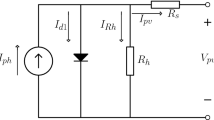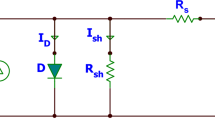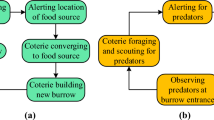Abstract
The word’s demand for renewable energy has be rinsing incrementally. One of the solutions for the energy crisis is photovoltaic. However, the design and development of better performing photovoltaic cells and modules requires accurate extraction of their intrinsic parameters. Metaheuristic algorithms have been reported to be the best methods for obtaining accurate values of these intrinsic parameters. However, local convergence goes against the recently devised heuristic methods and inhibits them from producing optimal result. This paper proposes a hybrid method that is based on the Newton Raphson method and a self-adaptive algorithm called the Drone Squadron Optimisation. The latter is an artifact technique inspired by the simulation of a drone squadron from a command centre. It is proposed that this hybrid method can help extract the best intrinsic parameters of photovoltaic cell and module. This study also provides insights and clarification on the reported approaches that have been recently proposed to formulate the objective function. Further, this study also computes and compares the ten best recently published heuristics algorithms in the domain of photovoltaic estimation. The study’s results obtain point to the difference between the two formulations and the accuracy of the best formulation. The results obtained from the six case studies covered in this study present the combined performance of the Newton Raphson method and Drone Squadron Optimisation to extract the accurate parameters of a photovoltaic module.











Similar content being viewed by others
Abbreviations
- CBC :
-
The current best coordinates
- CBOFV :
-
The current best coordinates objective function
- D :
-
Dimension
- ε :
-
Stopping criteria
- E :
-
Solar irradiance
- F (θ):
-
Objective function to minimize
- I :
-
Cell output current (A)
- I d, I d 1, I d 2 :
-
Diode currents (A)
- I iext (θ):
-
Estimated current
- I i :
-
Measured current (A)
- I 0, I 01, I 02 :
-
Diode reverse saturation currents (μA)
- I p :
-
Current through parallel resistor (A)
- I ph :
-
Photoelectric current (A)
- I sc :
-
Short-circuit current (A)
- k:
-
Boltzman constant (J/K)
- k i :
-
Temperature coefficient of Isc (A/K)
- LB:
-
Lower bound
- n, n 1, n 2 :
-
Diode ideality factors
- N :
-
Number of the experimental I–V data pairs
- N S :
-
Number of cells connected in series
- OF :
-
Objective function
- θ :
-
Vector of parameters
- P :
-
Firmware perturbation
- P acc :
-
Probability for the worst solution to be accepted
- q :
-
Electron charge (C)
- R P :
-
Parallel resistance (Ω)
- R S :
-
Series resistance (Ω)
- RMSE :
-
Root mean square error
- STC :
-
Standard testing condition (1000 W/m2, 25 °C)
- T :
-
Temperature (K)
- TC :
-
Trial coordinates
- TmOFV :
-
The team’s objective function
- TmC :
-
The team’s coordinates
- U (0, 1):
-
Random uniform distribution between 1 and 0
- UB :
-
Upper bound
- V :
-
Cell output voltage (V)
- V d :
-
Voltage applied across the diode (V)
- V i :
-
Measured voltage (V)
- V mp :
-
Voltage at the maximum power point (V)
- V oc :
-
Open-circuit voltage (V)
- V t :
-
Thermal voltage (V)
- ABC:
-
Artificial bee colony
- ABSO:
-
Artificial bee swarm optimization
- ABC-TRR:
-
Hybrid trust-region reflective algorithm
- C-HCLPSO:
-
Chaotic heterogeneous comprehensive learning particle swarm optimizer
- CAO:
-
Coyote optimization algorithm
- CWOA:
-
Chaotic whale optimization algorithm
- CPSO:
-
Chaos particle swarm optimization
- CSO:
-
Cat swarm optimization
- DE/WOA:
-
Hybrid differential evolution with whale optimization algorithm
- DDM:
-
Double diode model
- DSO:
-
Drone Squadron Optimization
- EHA-NMS:
-
Hybrid adaptive Nelder-Mead simplex algorithm
- ELPSO:
-
Enhanced leader particle swarm optimisation
- ESCE-OBL:
-
Enhanced shuffled complex evolution algorithm improved by opposition-based learning
- EVPS:
-
Enhanced vibrating particles system algorithm
- FPSO:
-
Flexible particle swarm optimization
- GOFPANM:
-
Hybrid flower pollination algorithm
- HBCS:
-
Hybridizing cuckoo search algorithm
- HFAPS:
-
Hybrid firefly and pattern search algorithms
- IADE:
-
Improved adaptive differential evolution algorithm
- IJAYA:
-
Improved Jaya
- IMFO:
-
Improved moth-flame optimization
- ISCA:
-
Opposition-based sine cosine algorithm
- ISCE:
-
Improved shuffled complex evolution
- ITLBO:
-
Improved teaching learning-based optimization
- IWAO:
-
Improved whale optimization algorithm
- MADE:
-
Memetic adaptive differential evolution
- MLBSA:
-
Multiple learning backtracking search algorithm
- MPSO:
-
Particle swarm optimisation with adaptive mutation
- NoCuSa:
-
Nonhomogeneous cuckoo search algorithm
- ORcr-IJADE:
-
Advanced onlooker-ranking-based adaptive differential evolution
- PGJAYA:
-
Performance-guided JAYA
- PV:
-
Photovoltaic
- RcrIJADE:
-
Improved adaptive differential evolution with crossover rate repairing
- SATLBO:
-
Self-adaptive teaching–learning-based optimization
- SDA:
-
Successive discretization algorithm
- SFO:
-
Sunflower optimization algorithm
- SOS:
-
Symbiotic organisms search
- Std:
-
Standard deviation
- TLABC:
-
Teaching–learning-based artificial bee colony
- tvACPSO:
-
Time-varying acceleration coefficients particle swarm optimisation
- WDOWOAPSO:
-
Collaborative swarm intelligence
References
Z.-F. Liu, L.-L. Li, M.-L. Tseng, M.K. Lim, Prediction short-term photovoltaic power using improved chicken swarm optimizer—extreme learning machine model. J. Clean. Prod. 248, 119272 (2020). https://doi.org/10.1016/j.jclepro.2019.119272
P.J. Gnetchejo, S. Ndjakomo Essiane, P. Ele, R. Wamkeue, D. Mbadjoun Wapet, S. Perabi Ngoffe, Important notes on parameter estimation of solar photovoltaic cell. Energy Convers. Manag. 197, 111870 (2019). https://doi.org/10.1016/j.enconman.2019.111870
G.-Q. Lin, L.-L. Li, M.-L. Tseng, H.-M. Liu, D.-D. Yuan, R.R. Tan, An improved moth-flame optimization algorithm for support vector machine prediction of photovoltaic power generation. J. Clean. Prod. 253, 119966 (2020). https://doi.org/10.1016/j.jclepro.2020.119966
Z. Chen, Y. Chen, L. Wu, S. Cheng, P. Lin, L. You, Accurate modeling of photovoltaic modules using a 1-D deep residual network based on I–V characteristics. Energy Convers. Manag. 186, 168–187 (2019). https://doi.org/10.1016/j.enconman.2019.02.032
P.J. Gnetchejo, S.N. Essiane, P. Ele, R. Wamkeue, D.M. Wapet, S.P. Ngoffe, Enhanced vibrating particles system algorithm for parameters estimation of photovoltaic system. JPEE 07(08), 1–26 (2019). https://doi.org/10.4236/jpee.2019.78001
P.A. Kumari, P. Geethanjali, Parameter estimation for photovoltaic system under normal and partial shading conditions: a survey. Renew. Sustain. Energy Rev. 84, 1–11 (2018). https://doi.org/10.1016/j.rser.2017.10.051
S. Lun et al., An explicit approximate I–V characteristic model of a solar cell based on padé approximants. Sol. Energy 92, 147–159 (2013). https://doi.org/10.1016/j.solener.2013.02.021
A. Jain, A. Kapoor, Exact analytical solutions of the parameters of real solar cells using Lambert W-function. Sol. Energy Mater. Sol. Cells 81(2), 269–277 (2004). https://doi.org/10.1016/j.solmat.2003.11.018
S. Lun, C. Du, T. Guo, S. Wang, J. Sang, J. Li, A new explicit I–V model of a solar cell based on Taylor’s series expansion. Sol. Energy 94, 221–232 (2013). https://doi.org/10.1016/j.solener.2013.04.013
G. Petrone, G. Spagnuolo, Parameters identification of the single-diode model for amorphous photovoltaic panels, in 2015 International Conference on Clean Electrical Power (ICCEP) (Taormina, Italy, 2015), pp. 105–109. https://doi.org/10.1109/ICCEP.2015.7177608
V. Lo Brano, G. Ciulla, An efficient analytical approach for obtaining a five parameters model of photovoltaic modules using only reference data. Appl. Energy 111, 894–903 (2013). https://doi.org/10.1016/j.apenergy.2013.06.046
A.K. Tossa, Y.M. Soro, Y. Azoumah, D. Yamegueu, A new approach to estimate the performance and energy productivity of photovoltaic modules in real operating conditions. Sol. Energy 110, 543–560 (2014). https://doi.org/10.1016/j.solener.2014.09.043
J. Appelbaum, A. Peled, Parameters extraction of solar cells—a comparative examination of three methods. Sol. Energy Mater. Sol. Cells 122, 164–173 (2014). https://doi.org/10.1016/j.solmat.2013.11.011
H. Chen, S. Jiao, M. Wang, A.A. Heidari, X. Zhao, Parameters identification of photovoltaic cells and modules using diversification-enriched Harris hawks optimization with chaotic drifts. J. Clean. Prod. 244, 118778 (2020). https://doi.org/10.1016/j.jclepro.2019.118778
W. Gong, Z. Cai, Parameter extraction of solar cell models using repaired adaptive differential evolution. Sol. Energy 94, 209–220 (2013). https://doi.org/10.1016/j.solener.2013.05.007
G. Petrone, M. Luna, G. La Tona, M. Di Piazza, G. Spagnuolo, Online identification of photovoltaic source parameters by using a genetic algorithm. Appl. Sci. 8(1), 9 (2017). https://doi.org/10.3390/app8010009
A. Askarzadeh, A. Rezazadeh, Artificial bee swarm optimization algorithm for parameters identification of solar cell models. Appl. Energy 102, 943–949 (2013). https://doi.org/10.1016/j.apenergy.2012.09.052
K. Yu, J.J. Liang, B.Y. Qu, X. Chen, H. Wang, Parameters identification of photovoltaic models using an improved JAYA optimization algorithm. Energy Convers. Manag. 150, 742–753 (2017). https://doi.org/10.1016/j.enconman.2017.08.063
K. Yu, X. Chen, X. Wang, Z. Wang, Parameters identification of photovoltaic models using self-adaptive teaching–learning-based optimization. Energy Convers. Manag. 145, 233–246 (2017). https://doi.org/10.1016/j.enconman.2017.04.054
G. Xiong, J. Zhang, D. Shi, Y. He, Parameter extraction of solar photovoltaic models using an improved whale optimization algorithm. Energy Convers. Manag. 174, 388–405 (2018). https://doi.org/10.1016/j.enconman.2018.08.053
X. Gao et al., Parameter extraction of solar cell models using improved shuffled complex evolution algorithm. Energy Convers. Manag. 157, 460–479 (2018). https://doi.org/10.1016/j.enconman.2017.12.033
S. Xu, Y. Wang, Parameter estimation of photovoltaic modules using a hybrid flower pollination algorithm. Energy Convers. Manag. 144, 53–68 (2017). https://doi.org/10.1016/j.enconman.2017.04.042
S. Li et al., Parameter extraction of photovoltaic models using an improved teaching–learning-based optimization. Energy Convers. Manag. 186, 293–305 (2019). https://doi.org/10.1016/j.enconman.2019.02.048
X. Chen, K. Yu, Hybridizing cuckoo search algorithm with biogeography-based optimization for estimating photovoltaic model parameters. Sol. Energy 180, 192–206 (2019). https://doi.org/10.1016/j.solener.2019.01.025
H. Chen, S. Jiao, A.A. Heidari, M. Wang, X. Chen, X. Zhao, An opposition-based sine cosine approach with local search for parameter estimation of photovoltaic models. Energy Convers. Manag. 195, 927–942 (2019). https://doi.org/10.1016/j.enconman.2019.05.057
L. Wu et al., Parameter extraction of photovoltaic models from measured I–V characteristics curves using a hybrid trust-region reflective algorithm. Appl. Energy 232, 36–53 (2018). https://doi.org/10.1016/j.apenergy.2018.09.161
X. Chen, B. Xu, C. Mei, Y. Ding, K. Li, Teaching–learning-based artificial bee colony for solar photovoltaic parameter estimation. Appl. Energy 212, 1578–1588 (2018). https://doi.org/10.1016/j.apenergy.2017.12.115
G. Xiong, J. Zhang, X. Yuan, D. Shi, Y. He, G. Yao, Parameter extraction of solar photovoltaic models by means of a hybrid differential evolution with whale optimization algorithm. Sol. Energy 176, 742–761 (2018). https://doi.org/10.1016/j.solener.2018.10.050
Y. Chen, Z. Chen, L. Wu, C. Long, P. Lin, S. Cheng, Parameter extraction of PV models using an enhanced shuffled complex evolution algorithm improved by opposition-based learning. Energy Proc. 158, 991–997 (2019). https://doi.org/10.1016/j.egypro.2019.01.242
N. Muangkote, K. Sunat, S. Chiewchanwattana, S. Kaiwinit, An advanced onlooker-ranking-based adaptive differential evolution to extract the parameters of solar cell models. Renew. Energy 134, 1129–1147 (2019). https://doi.org/10.1016/j.renene.2018.09.017
L. Guo, Z. Meng, Y. Sun, L. Wang, Parameter identification and sensitivity analysis of solar cell models with cat swarm optimization algorithm. Energy Convers. Manag. 108, 520–528 (2016). https://doi.org/10.1016/j.enconman.2015.11.041
A.M. Beigi, A. Maroosi, Parameter identification for solar cells and module using a hybrid firefly and pattern search algorithms. Sol. Energy 171, 435–446 (2018). https://doi.org/10.1016/j.solener.2018.06.092
H. Sheng et al., Parameters extraction of photovoltaic models using an improved moth-flame optimization. Energies 12(18), 3527 (2019). https://doi.org/10.3390/en12183527
S. Li, W. Gong, X. Yan, C. Hu, D. Bai, L. Wang, Parameter estimation of photovoltaic models with memetic adaptive differential evolution. Sol. Energy 190, 465–474 (2019). https://doi.org/10.1016/j.solener.2019.08.022
M.H. Qais, H.M. Hasanien, S. Alghuwainem, A.S. Nouh, Coyote optimization algorithm for parameters extraction of three-diode photovoltaic models of photovoltaic modules. Energy 187, 116001 (2019). https://doi.org/10.1016/j.energy.2019.116001
K. Yu, J.J. Liang, B.Y. Qu, Z. Cheng, H. Wang, Multiple learning backtracking search algorithm for estimating parameters of photovoltaic models. Appl. Energy 226, 408–422 (2018). https://doi.org/10.1016/j.apenergy.2018.06.010
G. Xiong, J. Zhang, X. Yuan, D. Shi, Y. He, Application of symbiotic organisms search algorithm for parameter extraction of solar cell models. Appl. Sci. 8(11), 2155 (2018). https://doi.org/10.3390/app8112155
D.T. Cotfas, A.M. Deaconu, P.A. Cotfas, Application of successive discretization algorithm for determining photovoltaic cells parameters. Energy Convers. Manag. 196, 545–556 (2019). https://doi.org/10.1016/j.enconman.2019.06.037
Z. Chen, L. Wu, P. Lin, Y. Wu, S. Cheng, Parameters identification of photovoltaic models using hybrid adaptive Nelder-Mead simplex algorithm based on eagle strategy. Appl. Energy 182, 47–57 (2016). https://doi.org/10.1016/j.apenergy.2016.08.083
H.G.G. Nunes, J.A.N. Pombo, P.M.R. Bento, S.J.P.S. Mariano, M.R.A. Calado, Collaborative swarm intelligence to estimate PV parameters. Energy Convers. Manag. 185, 866–890 (2019). https://doi.org/10.1016/j.enconman.2019.02.003
N.J. Cheung, X.-M. Ding, H.-B. Shen, A nonhomogeneous cuckoo search algorithm based on quantum mechanism for real parameter optimization. IEEE Trans. Cybern. 1, 12 (2016). https://doi.org/10.1109/TCYB.2016.2517140
M.H. Qais, H.M. Hasanien, S. Alghuwainem, Identification of electrical parameters for three-diode photovoltaic model using analytical and sunflower optimization algorithm. Appl. Energy 250, 109–117 (2019). https://doi.org/10.1016/j.apenergy.2019.05.013
K. Yu, B. Qu, C. Yue, S. Ge, X. Chen, J. Liang, A performance-guided JAYA algorithm for parameters identification of photovoltaic cell and module. Appl. Energy 237, 241–257 (2019). https://doi.org/10.1016/j.apenergy.2019.01.008
L.L. Jiang, D.L. Maskell, J.C. Patra, Parameter estimation of solar cells and modules using an improved adaptive differential evolution algorithm. Appl. Energy 112, 185–193 (2013). https://doi.org/10.1016/j.apenergy.2013.06.004
D. Yousri, D. Allam, M.B. Eteiba, P.N. Suganthan, Static and dynamic photovoltaic models’ parameters identification using chaotic heterogeneous comprehensive learning particle swarm optimizer variants. Energy Convers. Manag. 182, 546–563 (2019). https://doi.org/10.1016/j.enconman.2018.12.022
A. Rezaee Jordehi, Enhanced leader particle swarm optimisation (ELPSO): an efficient algorithm for parameter estimation of photovoltaic (PV) cells and modules. Sol. Energy 159, 78–87 (2018). https://doi.org/10.1016/j.solener.2017.10.063
M. Merchaoui, A. Sakly, M.F. Mimouni, Particle swarm optimisation with adaptive mutation strategy for photovoltaic solar cell/module parameter extraction. Energy Convers. Manag. 175, 151–163 (2018). https://doi.org/10.1016/j.enconman.2018.08.081
A.R. Jordehi, Time varying acceleration coefficients particle swarm optimisation (TVACPSO): a new optimisation algorithm for estimating parameters of PV cells and modules. Energy Convers. Manag. 129, 262–274 (2016). https://doi.org/10.1016/j.enconman.2016.09.085
P. J. Gnetchejo, S. Ndjakomo Essiane, P. Ele, R. Wamkeue, D. Mbadjoun Wapet, S. Perabi Ngoffe, Reply to comment on ‘important notes on parameter estimation of solar photovoltaic cell’, by Gnetchejo et al. [Energy Conversion and Management, https://doi.org/10.1016/j.enconman.2019.111870] . Energy Convers. Manag. 201, 112132 (2019). https://doi.org/10.1016/j.enconman.2019.112132
V.V. de Melo, W. Banzhaf, Drone Squadron Optimization: a novel self-adaptive algorithm for global numerical optimization. Neural Comput. Appl. 30(10), 3117–3144 (2018). https://doi.org/10.1007/s00521-017-2881-3
H.G.G. Nunes, J.A.N. Pombo, S.J.P.S. Mariano, M.R.A. Calado, J.A.M. Felippe de Souza, A new high performance method for determining the parameters of PV cells and modules based on guaranteed convergence particle swarm optimization. Appl. Energy 211, 774–791 (2018). https://doi.org/10.1016/j.apenergy.2017.11.078
A. Hazra, S. Das, M. Basu, An efficient fault diagnosis method for PV systems following string current. J. Clean. Prod. 154, 220–232 (2017). https://doi.org/10.1016/j.jclepro.2017.03.214
V. V. de Melo, A novel metaheuristic method for solving constrained engineering optimization problems: Drone Squadron Optimization. arXiv:1708.01368 [cs, math] (2017). Accessed December 05, 2019
Author information
Authors and Affiliations
Corresponding author
Additional information
Publisher's Note
Springer Nature remains neutral with regard to jurisdictional claims in published maps and institutional affiliations.
Rights and permissions
About this article
Cite this article
Gnetchejo, P.J., Ndjakomo Essiane, S., Dadjé, A. et al. A Self-adaptive Algorithm with Newton Raphson Method for Parameters Identification of Photovoltaic Modules and Array. Trans. Electr. Electron. Mater. 22, 869–888 (2021). https://doi.org/10.1007/s42341-021-00312-5
Received:
Revised:
Accepted:
Published:
Issue Date:
DOI: https://doi.org/10.1007/s42341-021-00312-5




